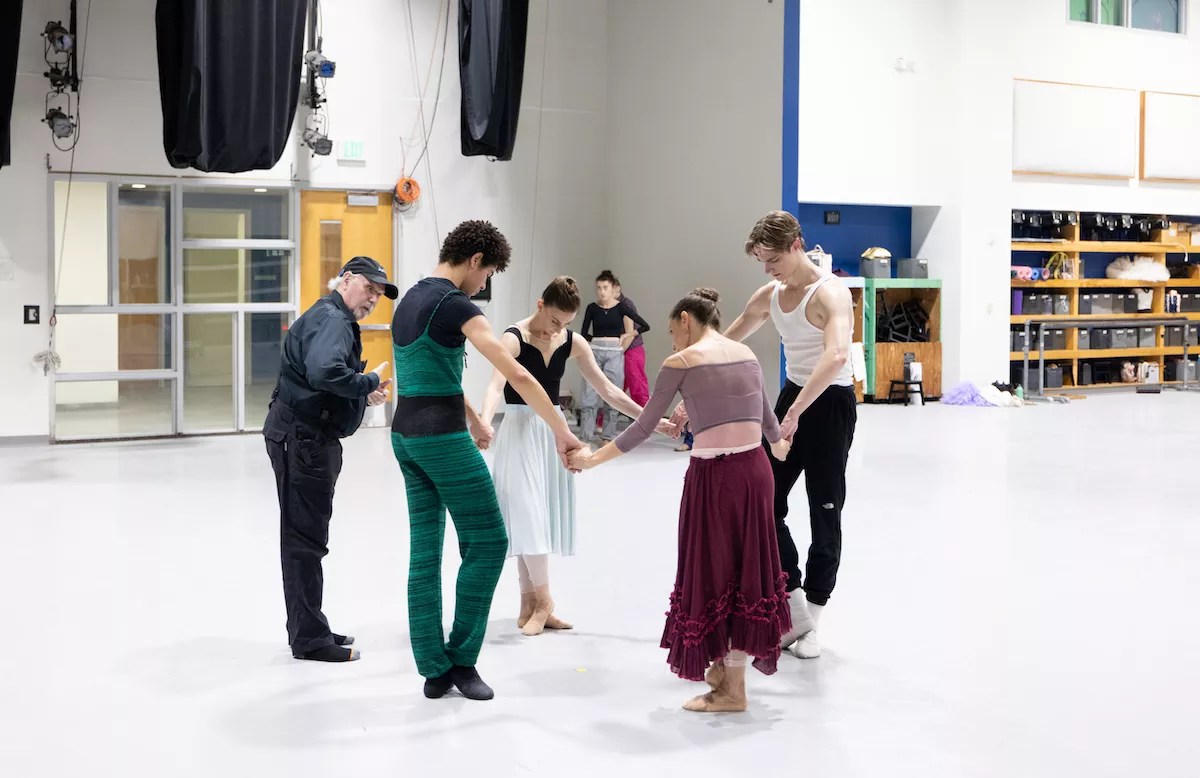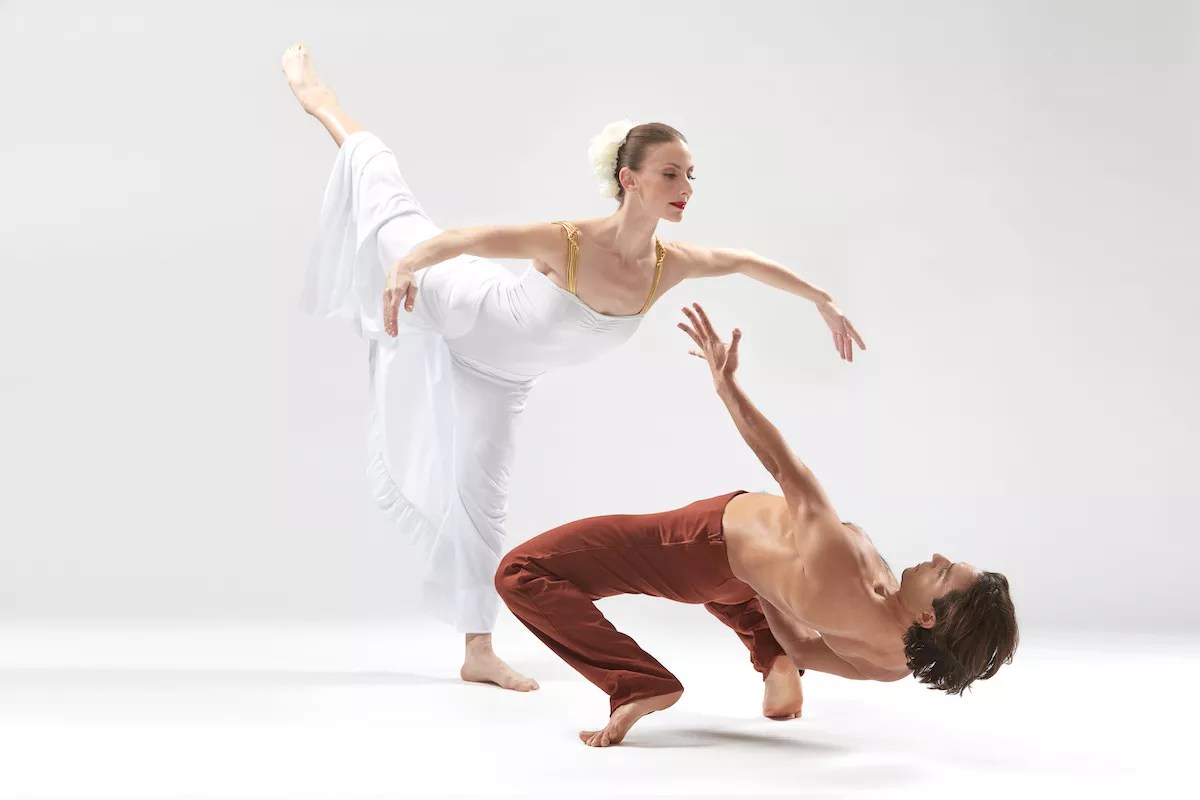
Photo by Gary James

Audio By Carbonatix
Miami City Ballet’s second program of the season brings together new and venerable creative voices, showcasing the back and forth between ballet and modern dance. Two here-and-now works are in good company with two classics in “Modern Masters,” which opens at the Arsht Center on Friday, February 10.
The program’s title points to Martha Graham and José Limón, towering 20th-century figures who could provide points of reference for the highest aims of the featured on-the-rise choreographers Amy Hall Garner and Pontus Lidberg. To this track also come the MCB dancers, who are amply skilled in the ballets of George Balanchine and always game for an array of expression. Just so, noble spirits of the past and practitioners full of present energy will converge for the splendor of timeless artistry.
On view, Limón’s 1949 quartet The Moor’s Pavane, using music by English Baroque composer Henry Purcell and distilling drama from Shakespeare’s Othello, was created in a period when there were still notable artistic barricades between ballet and modern dance camps. Yet by 1970, this found its way into the repertory of American Ballet Theatre, and even the legendary Rudolf Nureyev embraced the Moor. MCB first staged the work more than three decades ago.
Graham’s Diversion of Angels, to American composer Norman Dello Joio’s pulsating score, premiered under a different name a year earlier than Limón’s piece at the same venue, Connecticut College, then hosting the American Dance Festival, a hothouse for modern dance. It was a burst of enduring brightness, with Graham’s admiration for the vibrant colors in Wassily Kandinsky’s paintings informing her design, the lead women’s costumes hue-coded to choreographic themes: yellow for the flickers of young flirtation; red for romance on high heat; and white for maturity’s cut-marble devotion. MCB first performed this at Jacob’s Pillow in Becket, Massachusetts, just last summer.
When news happens, Miami New Times is there —
Your support strengthens our coverage.
We’re aiming to raise $30,000 by December 31, so we can continue covering what matters most to you. If Miami New Times matters to you, please take action and contribute today, so when news happens, our reporters can be there.

Miami City Ballet Dancers rehearsesPetrichor for the “Modern Masters” program.
Photo by Alexander Iziliaev
Those journeys of modern dance to ballet companies, so frequent and valued now, might seem wondrous, seen from the foundational era Limón documented in his An Unfinished Memoir. Though appreciative of contemporary ballets himself, he reports, “The clash of artistic ideologies during this period occasionally had a tragicomical aspect.” He describes, for instance, how in a lecture demonstration, Graham – her tigress defense at the ready – was heckled by none other than ballet luminary Michel Fokine.
Even so, militants in stylistic trenches could also turn into comrades-in-arms. Dante Puleio, artistic director of the Limón Dance Company, salutes in MCB’s staging of The Moor’s Pavane. As he puts it, “An opportunity like this lets us extend our work, and that’s how dance history gets passed along – continuing the story of who Limón was.”
Puleio refers to the accomplishments of the Mexican immigrant to the U.S., a great choreographer and an unsurpassed exemplar of male dancing who proved exceptional in his time and place. Notably, Limón’s body of work is the first to have stayed active so long in his own and other companies after the creator’s death.
According to Puleio, The Moor’s Pavane excels in choreography “so clear and beautifully executed that in twenty minutes, four dancers in their courtly dance wrap you up intimately in storytelling with the impact of the big works in ballet repertoire.”

Daniel Lewis with Luiz Silva, Samantha Hope Galler, Cameron Catazzaro, and Ashley Knox rehearsing The Moor’s Pavane.
Photo by Alexander Iziliaev
Puleio counted on Kurt Douglas, the first African-American to perform the Iago-based role in The Moor’s Pavane, to set the piece on the MCB casts. They were then fine-tuned with coaching from specialist Daniel Lewis, founding dean of dance at Miami’s New World School of the Arts and once a Limón company star.
“Whereas ballet is mostly about how light you can be,” Puleio explains, “in Limón, dancers must drop their weight exhibiting heaviness when needed.” And that exploration of gravity extends to Graham’s language, alongside her particular use of midriff contractions and floor work.
“In Moor’s Pavane, performers also need to not just show but live inside emotion for greater impact,” says Puleio. Spatial awareness also involves not anticipating but reacting to what others are doing.
Luckily, MCB dancers have proven true to the task. They’ve shown comparable eagerness crossing into Garner’s Resplendent Fantasy and Lidberg’s Petrichor, company commissions from artists at ease with stylistic fluidity.
With a career covering ballet, modern dance, and musical theater, Garner traces her artistic range back to her Alabama roots and through a Juilliard education. Commissions led her, mid-pandemic, to an MCB-Paul Taylor Dance Company joint project, a remotely choreographed screen duet titled ViVa. A recent MCB collaboration with Joffrey Ballet funded her “Rita Finds Home,” a young people’s ballet performed by MCB School’s pre-professional division throughout South Florida.
The whimsical portrayal of an artistic girl’s journey has special meaning for Garner now that she’s the mother of a 6-year-old boy.
Through all her varied creative endeavors, Garner confesses, “It’s music with momentum that gets my choreographic wheels turning.”

Miami City Ballet dancers Francisco Schilereff and Samantha Hope Galler in Resplendent Fantasy
Photo by Alexander Izilieav
The three-section Resplendent Fantasy uses mood-setting compositions by Oliver Davis (the born-to-be-danced Infinite Ocean), Jonathan Dove (the third movement of “Piano Quintet”), and, intriguingly, early 20th-century Armenian priest Komitas (the folk-inspired “Krunk”).
“I really want this to be about the marriage of movement and music,” Garner says. No better entry point, then, for the five-member MCB casts, already standard bearers for Balanchine’s oft-repeated dictum to see the music and hear the dance.
Rehearsing the Davis section of Resplendent Fantasy at an MCB studio a few days before her premiere, Garner encouraged Ariel Rose and Rui Cruz in both classical amplitude and her own brand of energy, running in quirky circuits from their mid-section to their limbs. They seemed to be pulling in bliss from the music – from the air.
“I like to make dances full of positivity and joy,” emphasizes the choreographer. “It empowers audiences by leaving them on a high.”
Ten dancers in another studio – from corps members to principals interweaving briskly across ranks – were learning to scuttle and cluster in Lidberg’s Petrichor, the choreographer tightening up their patterns to Philip Glass’s “Violin Concerto No. 1.” The breeze-by moves and sudden surges – robust but elusive – gave hints of “The Smell of Earth After Rain,” the subtitle Lidberg gives to his piece’s recondite name.

Samantha Hope Galler and Ariel Rose in Diversion of Angels
Photo by Gary James
“It’s something we all know but can’t quite put our fingers on,” explains Lidberg. “And I like it when dance evokes that. I want my piece to be transportive – with a degree of abstract narrative but not necessarily a story.”
The Swedish dance and filmmaker’s commissions have ranged from the Martha Graham Dance Company to Paris Opera Ballet. In fact, a screenwork of his first caught the attention of MCB artistic director Lourdes Lopez more than a decade ago. Petrichor now plumbs the possibilities of ballet – in which he was trained though he also studied modern dance.
“We all rest on the shoulders of giants, but there are many giants,” Lindberg says. Yet he remains “more of a searcher than a follower. I’m very open and can push in many different directions. But my process starts with finding out all that lives in the dancers’ bodies, what the soul of a company is, and then I move forward.”
Lidberg and Garner discovered bounty in MCB dancers. As Puleio judges, “They have what ballet and modern dance look for at the moment – as much versatility as possible. That comes down to not being afraid of vulnerability in exploring a new space. They are such exquisite artists that it’s easy to share that with them as they take it and make it something incredible.”
– Guillermo Perez, ArtburstMiami.com
Miami City Ballet’s “Modern Masters.” 7:30 p.m. Friday, February 10, and Saturday, February 11; and 2 p.m. Sunday, February 12, at Adrienne Arsht Center for the Performing Arts, 1300 Biscayne Blvd., Miami; and 7:30 p.m. Saturday, March 4, and 2 p.m. Sunday, March 5, at Broward Center for the Performing Arts, 201 SW Fifth Ave., Fort Lauderdale; 305-929-7010; miamicityballet.org. Tickets cost $39 to $189.